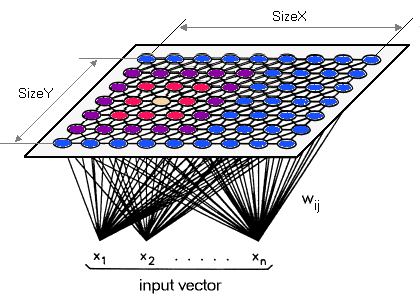| Fundamentals of Statistics contains material of various lectures and courses of H. Lohninger on statistics, data analysis and chemometrics......click here for more. |

|

Home  Multivariate Data Multivariate Data  Modeling Modeling  Classification and Discrimination Classification and Discrimination  Self Organizing Maps Self Organizing Maps |
|
| See also: ANN - Introduction | |
Kohonen NetworksThe Kohonen network (or "self-organizing map" or SOM, for short) has been developed by Teuvo Kohonen. The basic idea behind the Kohonen network is to set up a structure of interconnected processing units ("neurons") which compete for the signal. While the structure of the map may be quite arbitrary, most implementations support only rectangular and linear maps.
The SOM defines a mapping from the input data space spanned by x1..xn onto a one- or two-dimensional array of nodes. The mapping is performed in such a way that the topological relationship in the n-dimensional input space is maintained when mapped to the SOM. In addition, the local density of data is also reflected by the map: areas of the input data space which are represented by more data are mapped onto a larger area of the SOM. Each node of the map is defined by a vector wij which is
adjusted during the training. The basic training algorithm is quite simple:
2) find the node which is closest to the selected data (i.e. the distance between wij and the training data is a minimum) 3) adjust the weight vectors of the closest node and the nodes around it in such a way that the wij move towards the training data 4) repeat from step 1) for a fixed number of repetitions Kohonen maps may be arranged in any neighborhood relationship. A simple
but interesting application is the usage of Kohonen maps to solve the travelling salesman problem. Start the interactive example to see how it works. You can also go to the DataLab to perform some further experiments with Kohonen networks.
|
|
Home  Multivariate Data Multivariate Data  Modeling Modeling  Classification and Discrimination Classification and Discrimination  Self Organizing Maps Self Organizing Maps |
|


